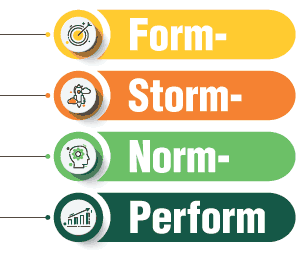Over the past 40-plus years, I have been involved with or observed countless groups, large and small, and how they function.
Most have worked effectively, a number superbly and a few abysmally. But regardless of whether I am participating or looking over their shoulders, I have learned that a simple framework identified in the 1960s is a great lens through which to assess how well each group accomplishes what it sets out to do.
This framework has been labeled form-storm-norm-perform. Some of you reading this may think, “I’ve heard this before” and want to find something more interesting to do. But bear with me because there is a magic in this process that, when we observe it, will help us be more effective, whether we are leading a group or simply participating.
Originally postulated in 1965 by psychological researcher Bruce Tuckman, it offers a way to understand how a group of people come together for a purpose and proceed to accomplish it. It doesn’t matter whether the group has been formed to accomplish a specific task or is of an ongoing nature such as a board of directors. The process works essentially the same way.
A group is formed when several people come together voluntarily, are assigned to work on a task or accept positions of responsibility in an organization. This could mean, for instance, a bunch of neighbors forming an informal sports league, a team of professionals assigned to a project, or perhaps several members of an association being elected to the board of directors.
The second step is storming. This is when the members of the group size each other up as to personalities, skills, abilities, interests, patience, self-esteem, approaches to communication and any other characteristics that may impact the group’s ability to function effectively. Tuckman called it storming because not everyone in any group will see completely eye-to-eye. There may be differences about vision, approach, logistics, or use of resources. There will inevitably be issues around power, influence, and the politics that emerge anytime two or more people gather. Over time, hopefully not too long, each member finds and accepts his or her position within the group. Optimally, these positions reflect their skills, personalities and desires around their role. Truth is, it is the rare group where everyone settles in without feeling a bit of compromise. This is when the third step begins.
Once the storming has taken place, the group will transition to a process of norming. They will come to agreement on vision, goals, objectives, resources, roles and approach. They will also sort out the logistics — when to meet, where and for how long. Who records the proceedings? Who takes on what outside tasks? Who leads or facilitates? And even who mediates when there are disagreements? As the group continues to meet, people accept their roles and complete both their individual tasks and their responsibilities to group function. If the group is functioning well, each member develops some perspective about the others, his or her own skills and a sense of group dynamics that can be carried forward to future groups.
As this norming process is established, the group begins to perform. Once the norming process is complete, for the most part, the group functions optimally. Of course, this functionality can be impacted by one or more of three factors:
- First, the makeup of the group might change.
- Second, the vision or goals of the group might be modified by outside forces, such as a boss altering the assignment or perhaps an evolution within the group about its outcome.
- Third, outside forces, such as a new regulation, a company buyout or changing business conditions, materially impact how the group needs to function.
In each case, the group returns to either the storming or norming phase as it sorts through how to absorb these changes. Once it has, it begins to perform again as planned.
Numerous articles and books have been published about form-storm-norm-perform over the years, but I hope this short overview inspires you to revisit these principles and how they apply to the groups and organizations with which you interact. As someone who spends a great deal of time studying the art and science of how decisions are made, I have found form-storm-norm-perform invaluable to my understanding of why people and groups make the choices they do. Tell me what you think in the comments below.
MANA welcomes your comments on this article. Write to us at [email protected].


